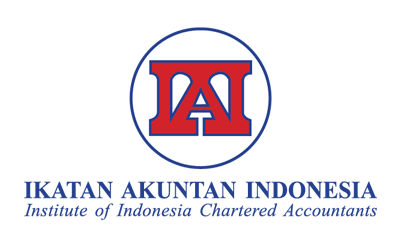KRITIK TERHADAP KLAIM KEANDALAN PADA HIRARKI PENGUKURAN NILAI WAJAR: Sebuah Literature Review
Abstract
Keywords
Full Text:
PDFReferences
Ayres, D., Huang, X. S., & Myring, M. (2017). "Advances in Accounting Fair value accounting and analyst forecast accuracy". Advances in Accounting, 37, 58–70. https://doi.org/10.1016/j.adiac.2016.12.004
Badia, M., Duro, M., Penalva, F., & Ryan, S. (2017). "Conditionally conservative fair value measurements". Journal of Accounting and Economics, 63(1), 75–98. https://doi.org/10.1016/j.jacceco.2016.10.006
Brown, G. (1998). "The idea that valuation is an art, not a science, is hardly mentioned these days". Journal of Property Valuation and Investment, 16(1). https://doi.org/10.1108/jpvi.1998.11216aaa.001
Crosby, N. (2000). "Valuation accuracy, variation and bias in the context of standards and expectations". Journal of Property Investment & Finance, 18(2), 130–161.https://doi.org/10.1108/14635780010324240
Dechow, P. M., Myers, L. A., & Shakespeare, C. (2009). "Fair value accounting and gains from asset securitizations: A convenient earnings management tool with compensation side-benefits". Journal of Accounting and Economics, 49(1–2), 2–25. https://doi.org/10.1016/j.jacceco.2009.09.006
Desmond, W. (2011). Analisis Fundamental Saham (Edisi ke-2.). Jakarta: Exceed.
Dorchester, J. (2011)."Market value, fair value, and duress". Journal of Property Investment &Finance, 29(4), 428–447. https://doi.org/10.1108/14635781111150321
Earley, C. E., Hoffman, V. B., & Joe, J. R. (2014). "Auditors’ Role in Level 2 versus Level 3 Fair-Value Classification Judgments". SSRN Electronic Journal, 1–42.
Ehalaiye, D., Tippett, M., & Zijl, T. Van. (2017). "Pacific-Basin Finance Journal The predictive value of bank fair values". Pacific-Basin Finance Journal, 41, 111–127. https://doi.org/10.1016/j.pacfin.2016.10.008
Emett, S. A., Libby, R., & Nelson, M. W. (2018). "Accounting, Organizations and Society PCAOB guidance and audits of fair values for Level 2 investments". Accounting, Organizations and Society, 71(June), 57–72. https://doi.org/10.1016/j.aos.2018.05.011
Francisco, C. L., & Javier, C. F. (2015). "Relevance of fair value of Brazilian banks securities in the financial crisis". International Journal of Emerging Markets, 10(4), 684–696. http://dx.doi.org/10.1108/IJoEM-11-2012-0150
Georgia, W. M. (2015). "Implications of Valuation Art and Science in decision making". Journal of Property Investment and Finance, 33(2). https://doi.org/10.1108/JPIF-01-2015-0001
Glasscock, R., Harless, D. W., & Dorminey, J. (2017). "Research in Accounting Regulation The curious case of Level 3 instruments". Research in Accounting Regulation, 29(1), 52–68. https://doi.org/10.1016/j.racreg.2017.04.006
Goh, B. W., Li, D., Ng, J., & Yong, K. O. (2015). "Market pricing of banks’ fair value assets reported under SFAS 157 since the 2008 financial crisis". Journal of Accounting and Public Policy, 34(2), 129–145. http://dx.doi.org/10.1016/j.jaccpubpol.2014.12.002
Harjanto, B., & Hidayati, W. (2001). Konsep Dasar Penilaian Properti (Edisi 2). Yogyakarta, Indonesia: BPFE Yogyakarta.
Hidayat, T. (2012). "Pengaruh Ukuran Kap Dan Auditor Tenure Terhadap Value Relevance Dari Nilai Wajar". Jurnal Akuntansi Dan Keuangan Indonesia Universitas Indonesia, 9(2), 171–188.
Ikatan Akuntan Indonesia. Standar Akuntansi Keuangan (SAK), Pub. L. No. 68 (2017). Indonesia.
Kaur, J. (2013). "The Fairness of the Fair Value Concept". International Journal of Business and Commerce, 3(3), 1–10.
King, J. E., & McLure, M. (2015). "Value: History of the Concept". In International Encyclopedia of Social & Behavioral Sciences, Elsevier (Second, Vol. 25, pp. 7–13). Elsevier. https://doi.org/10.1016/B978-0-08-097086-8.03123-8
Kohlbeck, M., Smith, T., & Valencia, A. (2017). "Auditors and net transfers of Level 3 fair-valued financial instruments". Advances in Accounting, 36, 27–39. https://doi.org/10.1016/j.adiac.2016.09.003
Landsman, W. R. (2007). "Is fair value accounting information relevant and reliable? Evidence from capital market research". Accounting and Business Research, (Special Issue from International Accounting Policy Forum), 19–30. https://doi.org/10.1080/00014788.2007.9730081
Liao, Y. (2013). " The impact of fairvalueaccounting on the relevance of capital adequacy ratios Evidence from Taiwan". Journal of Financial Reporting and Accounting, 39(3), 133154. http://dx.doi.org/10.1108/03074351311293990
Liao, L., Ang, H., Morris, R. D., & Tang, Q. (2013). "Information asymmetry of fair value accounting during the financial crisis". Journal of Contemporary Accounting & Economics, 9(2), 221–236. https://doi.org/10.1016/j.jcae.2013.10.001
Majercakova, D., & Skoda, M. (2015). "Fair value in financial statements after financial crisis". Journal of Applied Accounting Research, 16(3), 312–332. https://doi.org/10.1108/JAAR-07-2014-0069
Manganaris, P., Spathis, C., & Dasilas, A. (2015). "The effects of mandatory IFRS adoption and conditional conservatism on European bank values". Journal of International Accounting, Auditing and Taxation, 24(March), 72–81. https://doi.org/10.1016/j.intaccaudtax.2015.02.004
Masyarakat Profesi Penilai Indonesia. Standar Penilaian Indonesia (2015).
Murti, N. W., & Suyanto. (2017). "The Relevance of Fair Value Concept Compared to Historical Costs in Indonesia". In Indonesia Focus Proceeding ASIRPA USA (pp. 1–6).
Siekkinen, J. (2016). "Value relevance of fair values in different investor protection environments". Accounting Forum, 40(1), 1–15. https://doi.org/10.1016/j.accfor.2015.11.001
Šodan, S. (2015). "The impact of fair value accounting on earnings quality in eastern European countries". Procedia Economics and Finance, 32(15), 1769–1786. https://doi.org/10.1016/S2212-5671(15)01481-1
Wahyuni, E. T. (2013). Sukar Menakar Nilai Wajar : Tinjauan atas IFRS 13 Fair Value Measurement. Majalah Akuntan Indoneisa. Retrieved from http://etw-accountant.com/sukar-menakar-nilai-wajar-tinjauan-atas-ifrs-13-fair-value-measurement/#more-225, diakses tanggal 7 Februari 2017
DOI: https://doi.org/10.35591/wahana.v21i2.142
Wahana: Jurnal Ekonomi, Manajemen dan Akuntansi
ISSN : 2685-1415 (Online) | 1410-8224 (Print)
Published by Pusat Penelitian dan Pengabdian Masyarakat Politeknik YKPN Yogyakarta.
Jl. Gagak Rimang No. 2-4 Balapan, Yogyakarta 55222
Phone (0274) 560159, 562317, 513413, 563516 Fax. (0274) 561591
 This work is licensed under a Creative Commons Attribution-ShareAlike 4.0 International License.
This work is licensed under a Creative Commons Attribution-ShareAlike 4.0 International License.













